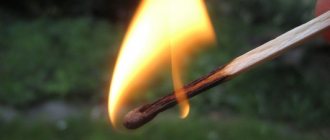Last updated - January 2022
It's no secret that the number of crimes recorded by law enforcement every year remains appalling. However, among this entire mass there are several categories of criminal acts that pose a particular danger not only to the individual victim, but also to society as a whole. One of these rather significant categories is crimes committed out of hooligan motives. Such motives and motivations are often called unreasonable, meaningless and insignificant. This is precisely their danger.
What does the Criminal Code mean by “inducements”
The disposition (in relation to a special part of the Criminal Code - a description of the act that is punishable) of each norm of the Criminal Code of the Russian Federation is the tip of the “iceberg” of all the conditions under which it is possible or not possible for a particular person to be held liable under it.
For each criminal act, the so-called “ subjective side ”, which characterizes the internal mental attitude of the criminal to the crime, is of particular importance. This component of each and every crime is characterized by:
- form of guilt (intention/negligence);
- the motive that prompted the commission of the crime;
- the goal that the criminal wanted to achieve as a result of committing illegal actions.
Hooligan motives are one of the possible elements of the subjective side of crimes. This is the reason, the motive for committing a criminal act, characterizing it to a greater extent as causeless, irrational, and the person who committed it as impudent in the worst sense of the word, unprincipled, ill-mannered, disregarding the foundations of society and the rights of other people, a person.
For a number of articles, the Criminal Code can give hooligan motives in two different versions:
- As a necessary sign of a crime, without which liability under the relevant article will not occur.
- As a qualifying feature that increases responsibility for the deed.
In addition, the Criminal Code contains several articles establishing punishment for acts for which hooligan motives are most typical. All these categories will be discussed below.
Categories of criminals
There is a certain qualification of criminals who have committed crimes based on hooligan motives. As a rule, these are the following types and categories of persons:
- People with an unstable psyche with signs of violence and a complete lack of positivity. Usually they do not commit significant actions, but at the same time they are guilty of many minor offenses that can be classified as immoral.
- People who have many bad habits that they don’t even try to get rid of. The most common is alcoholism. This is what usually leads to the commission of a criminal violation.
- Violently recurrent type of people. These are persons who were previously convicted of crimes with hooligan motives and received appropriate punishments. They basically lead an antisocial lifestyle, which is simply necessary for their existence. They commit new crimes very easily and also bear the prescribed punishment without strain.
- Dangerous repeat offenders. These are people previously convicted of violent crimes. The personality of such people is usually very deformed; they have no moral culture and cannot exist in society.
Hooligan urges
One of the fundamental documents for understanding what hooligan motives are is Resolution of the Plenum of the Armed Forces of the Russian Federation dated November 15, 2007 No. 45.
We can talk about hooligan motives when a criminal acts without a clear reason, his actions indicate a desire to cross the boundaries of what is permitted, to show that he is above society, neglects its foundations and rules of community, with them he expresses denial, disrespect, non-acceptance of norms and rules of behavior accepted in society.
For example , hooligan motives may be the desire to show one’s prowess, superiority over others, the ability to show cruelty, to mock someone, etc.
The Plenum Resolution indicates that crimes committed out of hooligan motives are deliberate illegal actions that encroach on a person himself or his property, committed without reason or using an insignificant reason.
Hooliganism
Responsibility for hooliganism is established by Article 213 of the Criminal Code. This is a crime committed with the only possible specific motive - hooliganism.
We should immediately separate two concepts - hooliganism, punishable under Art. 213 of the Criminal Code of the Russian Federation and what is commonly called such in everyday life.
It can be said that the word “hooliganism” used in everyday life can be revealed to some extent using the wording of the Criminal Code. In it, hooliganism is a gross violation of public order, expressing clear disrespect for society. However, criminal liability for it will only occur if there is an exhaustive list of conditions given in Part 1 of Art. 213, – if it is committed:
- using weapons or objects that were used as such;
- on any public transport (water, railway, air, etc.);
- based on hatred or enmity caused by the political, ideological, national, racial, religious views of the perpetrator or his extremely negative attitude towards any social group of people.
If these conditions are not met, criminal liability under Art. 213 is excluded.
The maximum possible punishment for such an act is up to 5 years of imprisonment for a composition not burdened with qualifying characteristics and up to 8 years for a qualified composition.
The courts are ordered to separate hooliganism from other crimes that may be committed for hooligan reasons. This separation occurs by carefully establishing:
- content and direction of intent;
- the purpose pursued by the perpetrator;
- circumstances of the commission of a criminal act.
Conviction of the perpetrators
Crimes with hooligan motivation are characterized by such immutable factors as insolence, rudeness and disregard for society!
All this manifests itself quite clearly and cannot but go unnoticed. It is for this reason that it is so important to normalize judicial practice and theory in this area. It is important to understand that conviction for these violations is not due when there is no clarity of motive, but when there are facts of gross violation of law and order.
Crimes associated with hooligan motives must necessarily involve violence. It is very closely related to hooliganism!
The judge must understand that if the motive is not clear, a crime still exists and should not be ignored.
Very often, to establish the exact guilt of the offender, they are sent for a psychiatric examination. A specialist can easily determine whether there is a hooligan motive in the criminal’s actions or whether he was driven by another motive.
If a hooligan motive is identified, completely different articles of the Criminal Code will be used to determine punishment. The reason is that in most cases they involve violence and are carried out on the basis of such motives as:
- Jealousy.
- Revenge.
- Necrophilia.
- Sadism.
An outsider or an illiterate person simply will not be able to recognize such signs. Even the criminal himself often does not see them. Nevertheless, they are always there, just hidden very deep inside.
Hooligan motives are a mandatory sign for liability under the Criminal Code
The current criminal code includes a number of articles on criminal acts, for which liability must be committed out of hooligan motives.
That is, the legislator determined that the illegal actions described in these articles are so dangerous for society that the perpetrator bears criminal liability for them only when committed out of such motives. These norms are available in different chapters of the code and the objects of encroachment also differ.
Beatings
The first and one of the most controversial and controversial articles due to the impunity of domestic violence is Art. 116 “Beatings.” This article is included in the chapter of the Criminal Code, which combines acts harmful to life and health.
Previously, it punished the infliction of injuries that did not cause harm to the health of the victim, regardless of the motives for the act. Currently, responsibility for all such damage, without hooligan motives, comes to the perpetrator under the Code of Administrative Offenses (CAO) under Article 6.1.1.
For criminal liability to arise, it is necessary that the beatings were committed either from hooligan motives, or motivated by hatred or enmity on the basis of ideology, religion, political views and beliefs, etc.
The maximum penalty for this crime is 2 years in prison.
Crimes harmful to public safety
As many as 3 norms of this chapter of the Criminal Code provide for liability for the acts described in them that are committed out of hooligan motives:
- Part 1 and 2 art. 207 – knowingly false report about a terrorist act, about actions being prepared that create a threat of death, and the occurrence of other dangerous consequences for society (explosion, poisoning, flooding, arson, etc.). The most severe punishment for such hooligan actions is forced labor from 2 to 3 years under Part 1, and imprisonment from 3 to 5 years under Part 2, if the message concerned social infrastructure facilities (schools, gardens, parks, hospitals, etc. ) or caused damage in the amount of at least 1 million rubles.
- Art. 215.2 – rendering life support facilities unusable. Destruction, damage and other actions are punishable, the result of which will be the unsuitability for further operation of energy facilities, telecommunications, housing and communal services, and other life support facilities for the population, ensuring the production and transportation of water, gas, heat, electricity, etc. to consumers. The maximum penalty is deprivation freedom for a “simple” offense – up to 3 years, up to 7 years if these actions caused the death of a person (part 3 of the article). For criminal liability to arise under this article, the perpetrator must have either hooligan motives or a selfish motive.
- Part 3-5 art. 215.3 – rendering oil, petroleum product, and gas pipelines, associated objects, structures, communications, automation, and alarm systems unusable. There are two conditions for liability under this rule:
- disruption of their normal stable operation or the possibility of its occurrence;
- hooligan or selfish motives.
The maximum punishment under normal conditions under Part 3 is up to 5 years of isolation from society, if these hooligan actions resulted in the death of a person or other grave consequences - up to 8 years (Part 5 of the article).
Crimes from other chapters
The Criminal Code contains 2 more crimes, for which hooligan motives are a necessary condition for liability. They are located in different chapters, respectively, the object of encroachment is also different:
- Art. 245 – cruelty to animals. This act violates public morality. Hooligan motives here are one of the alternative conditions for liability. Other conditions - the purpose of the act is to cause pain and suffering to the animal, selfish motives or death, injury to the victim. The most severe punishment for qualifying criteria under Part 2 (sadistic methods, presence of a minor, public demonstration of torture, etc.) is from 3 to 5 years of complete isolation from society.
- Art. 267.1 of the Criminal Code of the Russian Federation – committing actions that pose a threat to the safe operation of transport. In relation to this article, they are understood as any actions that result in a threat to the safety of people, their property, transported goods or the transport itself (for example, some time ago, cases of blinding pilots with laser pointers became more frequent). This act was included in the Criminal Code relatively recently - in April 2022. Such an act can result in up to 2 years in prison for the perpetrator.
Damage to property
Damage to property based on hooligan motives is considered a fairly common type of crime. In order for the offender to be convicted taking into account this factor, you will need to pay attention to the following points:
- The act resulted in severe damage or destruction of property;
- There are consequences for the wrongful act;
- There are motives that led to the offender destroying property.
It is in the presence of these factors that the difference between direct hooliganism and hooligan motives is most clearly manifested. For example, if property is completely destroyed and cannot be restored, the offender will be charged with hooliganism. If the property is subject to restoration, the crime will most likely be considered as committed against the backdrop of hooligan motives.
Such crimes can have a variety of consequences. And they must be taken into account in court:
- Causing harm to health;
- The victim has lost housing or lost funds;
- The organization or enterprise has ceased its activities;
- Buildings and, accordingly, people lost the opportunity to receive water, gas, heating and electricity.
Hooligan motives are a qualifying feature
According to statistics, the most common crimes are those committed for hooligan reasons that encroach on the life and health of specific people. In the articles of the Criminal Code prohibiting such acts, hooligan motives are a noticeably aggravating factor for the perpetrator. These are the following intentional acts:
- Murder – clause “i” of Part 2 of Art. 105. Taking the life of another person for hooligan reasons is a particularly serious act, which is punished very severely. The maximum penalty for such an act is imprisonment from 8 to 20 years, or life.
- Infliction of grievous bodily harm – paragraph “e” of Part 2 of Art. 111. The maximum penalty is up to 10 years in prison.
- Causing moderate harm to health – clause “e” of Part 2 of Art. 112 of the Criminal Code of the Russian Federation. The most severe punishment is up to 5 years in prison.
- Causing minor harm to health – paragraph “a” of Part 2 of Art. 115. The maximum penalty is imprisonment for up to 2 years.
In each case of bodily injury to the victim, the degree of harm caused to health is examined by forensic experts as part of a forensic examination.
Vera Viktorovna Dolganina
Practicing lawyer with more than 10 years of experience.
Ask a Question
Law enforcers (preliminary investigation bodies and the court), in order to conclude the presence of hooligan motives when using violence during an quarrel, fight, conflict, are ordered to find out which of the participants was their initiator (criminal or victim), whether the conflict was a provocation with a specific purpose - for using it as a reason to commit a crime.
In situations where the conflict was caused by the victim, as well as when it was caused by the unlawful behavior of the victim, hooligan motives of the perpetrator in relation to such a victim are excluded.
Another crime for which hooligan motives are a qualifying feature is encroaching on the property of citizens.
This is the intentional destruction or damage of someone else's property, committed out of hooligan motives. They are being prosecuted under Part 2 of Art. 167 of the Criminal Code of the Russian Federation. The most severe punishment for such an act is imprisonment for up to 5 years.
Acts with characteristic hooligan motives
In addition to the articles in which hooligan motives are either mandatory or an aggravating feature, which is directly stated in the articles themselves, the Criminal Code contains several rules on crimes for which such motives are most characteristic. These are, for example, the following criminal offenses:
- Vandalism (Article 214 of the Criminal Code of the Russian Federation) - desecration of buildings, structures, etc., damage to property in public places and on public transport. In the absence of qualifying signs, such actions are punishable by arrest for up to 3 months.
- Destruction or damage to objects of cultural heritage, etc. (Article 243 of the Criminal Code of the Russian Federation). The maximum penalty is up to 6 years in prison.
- Desecration of the bodies of the dead and their burial places (Article 244 of the Criminal Code of the Russian Federation) - damage, desecration of burial places of cemetery buildings for funeral or memorial rituals, grave structures, mockery, insulting mockery of dead bodies. In the absence of the qualifying criteria specified in Part 2 of the article, such actions may entail a penalty of arrest for up to 3 months.
Did the article help you?
Not really



